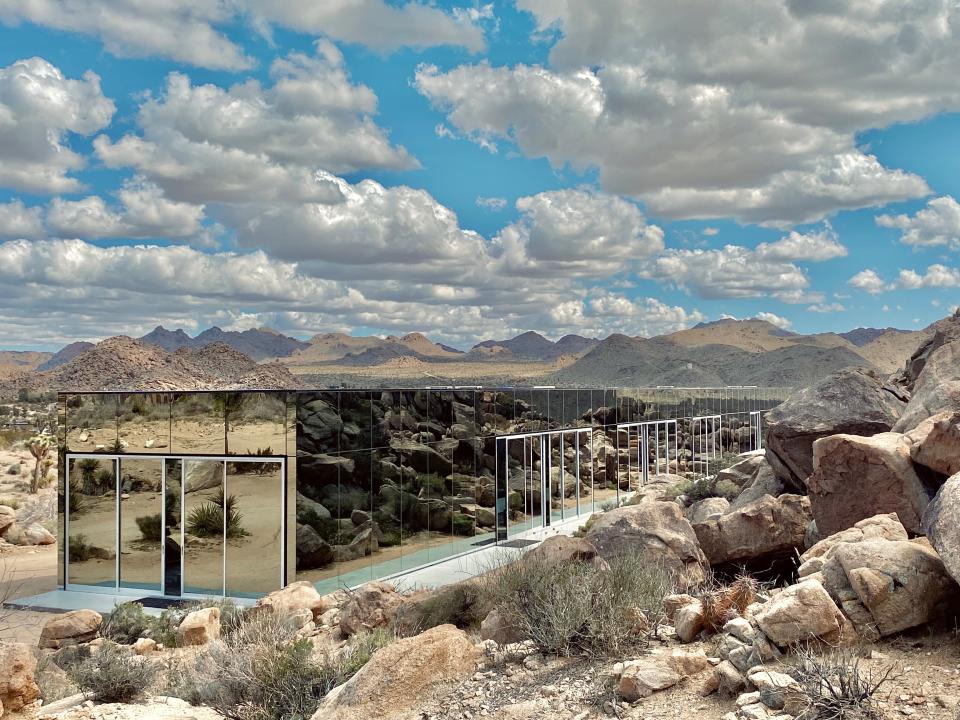
Did you ever look at the alien monolith from “2001: A Spacey Odyssey” and think, “Wow, I’d really like to live inside that”?
Well now you can (sort of) for the meager price of $18 million.
The Invisible House, a roughly 5,500-square-foot mirrored cuboid sitting on about 70 acres of land in Joshua Tree, Calif., is up for sale. The three-bedroom, four-bathroom space includes ultra-luxury home mainstays like a 100-foot indoor swimming pool and a chef’s kitchen integrated into a minimalist floor plan. The building is clad in nearly 100 solar panels that provide most of the building’s annual energy needs, according to owner Chris Hanley.
In the three years since it was built, the building has been featured in Netflix’s “The World’s Most Amazing Vacation Rentals” and, according to Hanley, has hosted celebrities such as Alicia Keys, Diplo and Demi Lovato and played host to numerous photos and videos shoots.
Hanley, a film producer whose resume includes an eclectic mix of films from “American Psycho” to “Spring Breakers,” worked with architect Tomas Osinski to design the house as a combination art project and living space.
“I’d originally thought of the ‘2001: (A) Space Odyssey’ monolith,” Hanley said. “Kind of like science fiction, but I saw it more like a work of art.”
Unlike the Space Odyssey monolith, which classic sci-fi fans will recall descended on Earth to change the course of human evolution and rewrite the natural order, Hanley said the Invisible House was designed to blend into its environment. The house sits on 100-foot steel beams similar to a cantilever bridge that leaves most of it hovering just above the desert floor.
“The footprint of the house is like a toothpick on the land,” Hanley said.

Hanley said the open desert surrounding the building, which borders Joshua Tree National Park, means a variety of native animals such as red-tailed hawks, owls, rabbits and coyotes can frequently be seen from the house.
“The quail used to get inside when we were building it,” Hanley said. “After it was built, generations of the quail were born there and they kind of used it. They live inside the rocks and underneath and in all the little crevices. The insects are sitting around on the walkways and the birds all eat them.”
He noted that, despite the name, birds don’t “smack into” the Invisible House, a phenomenon which could quickly shatter the illusion of unity with nature at an ultra-luxury desert retreat.
The house’s mirrored walls are actually a type of plate glass that, according to Hanley, “spectrally selects out the infrared and the ultraviolet” light.
This light filtering works with other temperature-regulating features like the building’s “cool roof” (a design that reflects significantly more light and heat than a conventional roof) and programmable blackout shades in the bedrooms to keep the Invisible House cool in the summer and warm in the winter.

The building has 92 360-watt solar panels and three 13-kilowatt Tesla powerwalls that provide roughly 85% of the building’s annual energy needs, according to Hanley. He said a new owner “could pretty much be off the grid” if they installed additional batteries for use during less sunny months.
The pool is heated by an additional 20 solar thermal panels and is chlorine free, cleaned by an ultraviolet light and an ozonator.
Despite these amenities, one of the main selling points of the house — and a primary justification for its $18 million price tag — is the media and entertainment industry buzz surrounding it.
The house has operated as a luxury short-term rental for the last several years, at points hosting high-profile guests like the aforementioned celebrities. Exposure such as its cameo in the animated music video for the remix of “Save Your Tears” with The Weekend and Ariana Grande added to this effect, increasing the buzz and air of desirability around the property.
“Nobody better call me and try to negotiate,” Henley said of the $18 million price tag. “I mean, the house makes like millions per year.”
When asked if that was primarily short-term rental income — the property is listed for roughly $3,000 per night on Airbnb (with a $629 cleaning fee) — Hanley said it also derived from the property’s use for photo and video shoots, alongside other paid events .

He said the space had been used by brands ranging from furniture company Design Within Reach and lighting company Flos to BMW and Cadillac Escalade to showcase their products in a unique setting.
“Basically they use this artistic space to create their own artistic vision,” Hanley said.
When discussing what type of person he believed would be a good buyer for one of the most expensive homes in the history of the high desert, the producers threw out ideas ranging from art fans and corporations to a crowd of 18 million fractional owners all chipping in $1.00
“Everyone in Joshua Tree could own the Invisible House — for not that much money!” Hanley said.
James B. Cutchin covers business in the Coachella Valley. Reach him at [email protected].
This article originally appeared on USA TODAY: Joshua Tree’s ‘Invisible House’ on sale for $18 million
